Ofcourse you can...
For building muscles you have some exercise...
Likewise to improve eyesight there is some exercise for eyes tooo
Many people believe that eye exercises can help improve vision or treat eye conditions.
Although there is limited evidenceTrusted Source to suggest that eye exercises can actually enhance vision, eye exercises can help with eye strain, certain eye conditions, and overall well-being.
Eye exercises can be particularly helpful for people who experience digital eye strain, which is related to the prolonged use of computers.
Read on to learn about seven eye exercises.
Eye exercises can be helpful for the following conditions:
•nystagmus, which is an eye movement condition
•strabismus, which is also an eye movement condition
•amblyopia
•myopia
•visual field defects
•dyslexia
•vergence problems
•ocular motility conditions
•accommodative dysfunction
•asthenopia
•convergence insufficiency
•visual field deficits following brain injury
•motion sickness
•learning difficulties
It is important to note that people with eye conditions such as retinopathy, cataracts, or glaucoma are unlikely to benefit from trying the eye exercises below.
The following are seven eye exercises that people may wish to try for the conditions listed above:
1. The 20-20-20 rule
Digital eye strain can become a problem for people who need to focus on a computer screen all day while working.
The 20-20-20 rule helps ease digital eye strain. The rule is easy: a person needs to look at something 20 feet away for 20 seconds every 20 minutes while working on a computer.
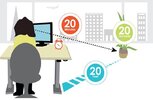
2. Focus change
The focus change exercise can also help with digital eye strain. People should perform this exercise while sitting.
1)Hold one finger a few inches away from one eye.
2)Focus the gaze on the finger.
3)Move the finger slowly away from the face.
4)Focus on an object farther away, and then back on the finger.
5)Bring the finger back closer to the eye.
6)Focus on an object farther away.
7)Repeat three times.
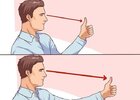
3. Eye movements
This eye movement exercise also helps with digital eye strain.
1)Close the eyes.
2)Slowly move the eyes upward, then downward.
3)Repeat three times.
4)Slowly move the eyes to the left, then to the right.
5)Repeat three times.
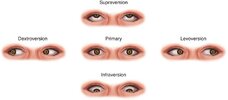
4. Figure 8
The figure 8 exercise can also help ease digital eye strain.
1)Focus on an area on the floor around 8 feet away.
2)Move the eyes in the shape of a figure 8.
3)Trace the imaginary figure 8 for 30 seconds, then switch direction.
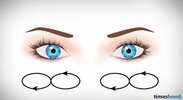
5. Pencil pushups
Pencil pushups can help people with convergence insufficiency. A doctor might recommend this exercise as part of vision therapy.
1)Hold a pencil at arm’s length, situated between the eyes.
2)Look at the pencil and try to keep a single image of it while slowly moving it toward the nose.
3)Move the pencil toward the nose until the pencil is no longer a single image.
4)Position the pencil at the closest point where it is still a single image.
5)Repeat 20 times.
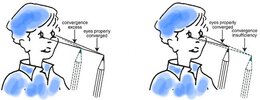
6.Brock string
The Brock string exercise helps improve eye coordination.
To complete this exercise, a person will need a long string and some colored beads. They can complete this exercise either sitting or standing.
1)Secure one end of the string to a motionless object, or another person can hold it.
2)Hold the other end of the string just below the nose.
3)Place one bead on the string.
4)Look straight at the bead with both eyes open.
If the eyes are working correctly, a person should see the bead and two strings in the shape of an X.
If one eye is closed, one of the strings will disappear, which means that the eye is suppressing. If the person sees two beads and two strings, the eyes are not converged at the bead.
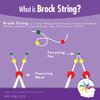
7.Barrel cards
Barrel cards is a good exercise for exotropia, which is a type of strabismus.
1)Draw three red barrels of increasing sizes on one side of a card.
2)Repeat in green on the other side of the card.
3)Hold the card against the nose so that the largest barrel is farthest away.
4)Stare at the far barrel until it becomes one image with both colors and the other two images have doubled.
5)Maintain the gaze for about 5 seconds.
6)Repeat the exercise with the middle and smallest images.

For building muscles you have some exercise...
Likewise to improve eyesight there is some exercise for eyes tooo
Many people believe that eye exercises can help improve vision or treat eye conditions.
Although there is limited evidenceTrusted Source to suggest that eye exercises can actually enhance vision, eye exercises can help with eye strain, certain eye conditions, and overall well-being.
Eye exercises can be particularly helpful for people who experience digital eye strain, which is related to the prolonged use of computers.
Read on to learn about seven eye exercises.
Eye exercises can be helpful for the following conditions:
•nystagmus, which is an eye movement condition
•strabismus, which is also an eye movement condition
•amblyopia
•myopia
•visual field defects
•dyslexia
•vergence problems
•ocular motility conditions
•accommodative dysfunction
•asthenopia
•convergence insufficiency
•visual field deficits following brain injury
•motion sickness
•learning difficulties
It is important to note that people with eye conditions such as retinopathy, cataracts, or glaucoma are unlikely to benefit from trying the eye exercises below.
The following are seven eye exercises that people may wish to try for the conditions listed above:
1. The 20-20-20 rule
Digital eye strain can become a problem for people who need to focus on a computer screen all day while working.
The 20-20-20 rule helps ease digital eye strain. The rule is easy: a person needs to look at something 20 feet away for 20 seconds every 20 minutes while working on a computer.

2. Focus change
The focus change exercise can also help with digital eye strain. People should perform this exercise while sitting.
1)Hold one finger a few inches away from one eye.
2)Focus the gaze on the finger.
3)Move the finger slowly away from the face.
4)Focus on an object farther away, and then back on the finger.
5)Bring the finger back closer to the eye.
6)Focus on an object farther away.
7)Repeat three times.

3. Eye movements
This eye movement exercise also helps with digital eye strain.
1)Close the eyes.
2)Slowly move the eyes upward, then downward.
3)Repeat three times.
4)Slowly move the eyes to the left, then to the right.
5)Repeat three times.

4. Figure 8
The figure 8 exercise can also help ease digital eye strain.
1)Focus on an area on the floor around 8 feet away.
2)Move the eyes in the shape of a figure 8.
3)Trace the imaginary figure 8 for 30 seconds, then switch direction.

5. Pencil pushups
Pencil pushups can help people with convergence insufficiency. A doctor might recommend this exercise as part of vision therapy.
1)Hold a pencil at arm’s length, situated between the eyes.
2)Look at the pencil and try to keep a single image of it while slowly moving it toward the nose.
3)Move the pencil toward the nose until the pencil is no longer a single image.
4)Position the pencil at the closest point where it is still a single image.
5)Repeat 20 times.

6.Brock string
The Brock string exercise helps improve eye coordination.
To complete this exercise, a person will need a long string and some colored beads. They can complete this exercise either sitting or standing.
1)Secure one end of the string to a motionless object, or another person can hold it.
2)Hold the other end of the string just below the nose.
3)Place one bead on the string.
4)Look straight at the bead with both eyes open.
If the eyes are working correctly, a person should see the bead and two strings in the shape of an X.
If one eye is closed, one of the strings will disappear, which means that the eye is suppressing. If the person sees two beads and two strings, the eyes are not converged at the bead.

7.Barrel cards
Barrel cards is a good exercise for exotropia, which is a type of strabismus.
1)Draw three red barrels of increasing sizes on one side of a card.
2)Repeat in green on the other side of the card.
3)Hold the card against the nose so that the largest barrel is farthest away.
4)Stare at the far barrel until it becomes one image with both colors and the other two images have doubled.
5)Maintain the gaze for about 5 seconds.
6)Repeat the exercise with the middle and smallest images.






 guruji
guruji
 ithukelama da munja thooki vaipa
ithukelama da munja thooki vaipa



